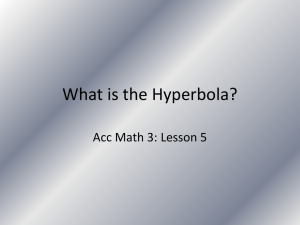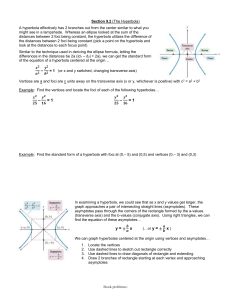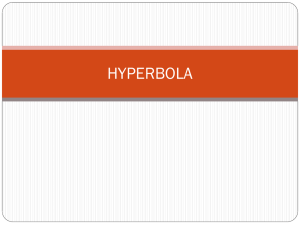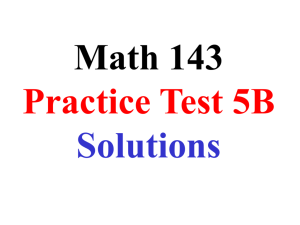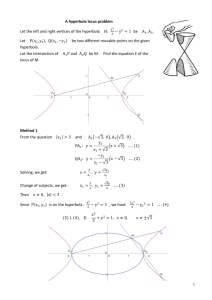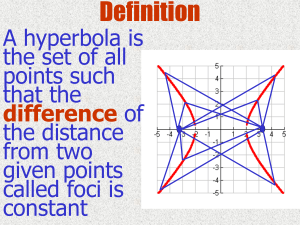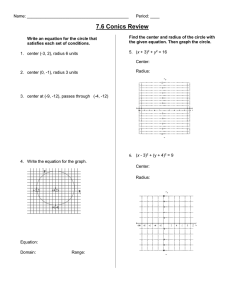The Hyperbola
advertisement
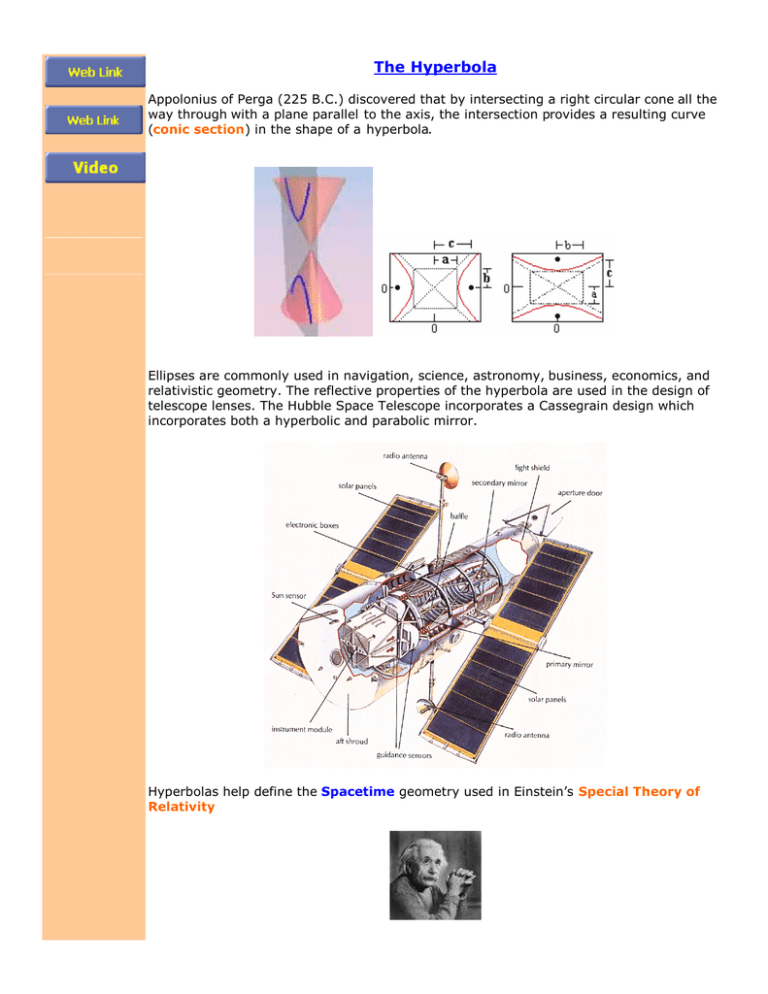
The Hyperbola Appolonius of Perga (225 B.C.) discovered that by intersecting a right circular cone all the way through with a plane parallel to the axis, the intersection provides a resulting curve (conic section) in the shape of a hyperbola. Ellipses are commonly used in navigation, science, astronomy, business, economics, and relativistic geometry. The reflective properties of the hyperbola are used in the design of telescope lenses. The Hubble Space Telescope incorporates a Cassegrain design which incorporates both a hyperbolic and parabolic mirror. Hyperbolas help define the Spacetime geometry used in Einstein’s Special Theory of Relativity A sonic boom shock wave has the shape of a cone, and it intersects the ground in part of a hyperbola. It hits every point on this curve at the same time, so that people in different places along the curve on the ground hear it at the same time. Because the airplane is moving forward, the hyperbolic curve moves forward and eventually the boom can be heard by everyone in its path. Like an ellipse, a hyperbola has two foci, two vertices, and a centre, but its shape is completely different. The Hyperbola in Terms of a Locus of Points A hyperbola is the set of points such that the magnitude (absolute value of) of the differences between the distances from any point on the curve to two fixed points (the foci), is constant. This constant value is the length of the transverse axis (the distance between the vertices). PF1 PF2 k 2a k In the ellipse, PF1 PF2 k The dashed lines are the asymptotes of the hyperbola. The asymptotes are not part of the actual hyperbola, but the are very useful in drawing the hyperbola. Note: the foci are outside the hyperbola, whereas in an ellipse, the foci are inside the ellipse. Anatomy of a Hyperbola The centre of the hyperbola is the midpoint of the two foci, F’F. The variable c represents the distance from the centre to either of the foci. 1 The vertices, V and V are on the same axis as the foci. The distance from the centre (the midpoint of V 1V) of the hyperbola to either of the vertices is the variable a. 1 The transverse axis is the line segment whose endpoints are V and V. The length of the transverse axis is 2a The conjugate axis is the line segment through the centre that is perpendicular to the transverse axis and whose endpoints are b units from the centre. The length of the conjugate axis is 2b. The Asymptotes are the two lines through the centre of the hyperbola that the ends of the hyperbola approach as the curve moves away from the centre. The asymptotes coincide with the diagonals of the 2a by 2b rectangle. The variables a, b, and c are related by the equation c a b . 2 2 2 Hyperbolas have the property that if a light ray (or radio signal) passes through (or is aimed at) one focus of the hyperbola and reflects of a hyperbolic surface (mirror) at a point P, then the reflected signal moves along a straight line determined by the the other focus and point P. If you design a mirror where one focus is the centre of a circle for the celestial sphere, then the light rays will be focus toward the one focus but will bounce off the mirror and all head toward the other focus. Equation of a Hyperbola with Centre (0,0) and Transverse Axis on x-axis The equation of a hyperbola with centre (0,0) and transverse axis on the x-axis is b y x a x2 y2 1 a 2 b2 b y x a Length of transverse axis: 2a Length of conjugate axis: 2b a ,0and a,0 c ,0and c,0 Vertices: Foci: Asymptotes: b b y x and y x a a Equation of a Hyperbola with Centre (0,0) and Transverse Axis on y-axis The equation of a hyperbola with centre (0,0) and transverse axis on the y-axis is y 2 x2 x2 y2 1 or 1 a 2 b2 b2 a 2 In this format, the term with the positive sign indicates the axis in which the curve opens. Length of transverse axis: 2a Length of conjugate axis: 2b a ,0and a,0 0, c 0, c and Vertices: Foci: Asymptotes: a a y x and y x b b Hyperbolas with Centre at (h, k) Horizontal Hyperbola Vertical Hyperbola x h x k 1 y k x h 1 2 2 a2 b2 Foci: h c , k and h c, k Vertices: h a, k and h a, k Asymptotes: b y x h k a 2 2 a2 b2 Foci: h ,k c and h, k c Vertices: h, k a and h, k a Asymptotes: a y x h k b Example For the hyperbola 9 x 2 4 y 2 36 , Find the length of the transverse and conjugate axes, the coordinates of the vertices, and the equations of the asymptotes. Solution: The standard form of the equation has a 1 on the right side. Therefore, we divide both sides of the equation by 36 9 x 2 4 y 2 36 36 36 36 x2 y2 1 4 9 This is the equation of the hyperbola with the transverse axis on the x-axis, since the term is positive. From the equation, we have a 2 4 a 2 b 2 9 b 3 x2 2a 2 2 4 The length of the transverse axis is The length of the conjugate axis is 2b 2 3 6 The coordinates of the vertices are a,0 2,0 and a,02,0. The equation of the asymptotes are b 3 b 3 y x x and y x x a 2 a 2 When drawing the hyperbola, we will use the asymptotes to guide us in the curves. First, we use the values of a and b to draw a box with width 2a (4 units) and height 2b (6 units) centred around the origin 0,0. Now we will draw two diagonal lines through the corners of the box. These lines are the asymptotes 3 3 y x and y x 2 2 2,0 and 2,0 , staying within the Now draw the hyperbola with vertices at asymptotes lines. Example Determine and sketch the equation of the hyperbola having foci at and with a conjugate axis of length 1,6and 1, 2 4 3. Solution: The hyperbola opens up and down since the foci are on a vertical axis. The centre of the hyperbola is We have 2c 8 so c=4 The value of b is We can determine 1 16 2 1, 2 , 2 2 h, k 2 3. a , via the equation c 2 a 2 b2 16 a 2 12 a 4 2 a 2 x h y k 2 This gives us the equation of the hyperbola 2 a2 b2 1 x 1y 2 1 2 4 2 12 Sketch the box centred at 1,2 with width of 2b 4 3 and height of 2a 4 . Now we will draw two diagonal lines through the corners of the box. These lines are the asymptotes y 1 1 x 12 and y x 12 3 3 Now draw the hyperbola with vertices at 0 h, k a 0 1,2 2 1,0 and 0 h, k a 0 1,2 2 1,4 , staying within the asymptotes lines. Example Determine the key properties of 9 x 2 y 2 81 Solution: The fist step is to rewrite the equation in standard form by dividing each term by 81 2 2 9x y 81 81 81 81 x2 y 2 1 9 81 Since the right side term equals 1, this is a horizontal hyperbola with centre (0, 0) Lengths of transverse and conjugate axis a2 9 , so a 3 2 b 81 , so b 9 The length of the transverse axis is 2a 2 3 6 The length of the conjugate axis is 2b 2 9 18 Vertices Since this is a horizontal hyperbola, the vertices are on the x-axis , a 3 units on either side of the centre (0,0): , 3,0 3,0 . Foci We need the value of c. c a b 2 2 2 9 81 90 c 3 10 Since this is a horizontal hyperbola, the foci are on the x-axis , side of the centre (0,0): , 3 10,0 3 10,0 . c 3 10 units on either Asymptotes The horizontal hyperbola has asymptotes with equations b 9 y x x 3x a 3 Example The long range navigation system (LORAN) uses hyperbolas to enable a ship to determine its exact location by radio. (This technique is becoming obsolete by the implementation of GSP (Global Positioning System, but it still used as backup). Two LORAN radio transmitters A and B are situated on a straight line separated by 200 km. The two stations simultaneously transmit signals at regular intervals. Determine an equation of a hyperbola described by the flight path of an aircraft when the on board radio receiver determines that it is 20 km closer to station B than to station A. Solution: The property that the difference of the distances from two points (foci) to another point is a fixed value k, is the locus definition of a hyperbola. Therefore the aircraft , P, is on a hyperbola with foci at F 1=(-100, 0) and F2=(100, 0), and the k value is 20. 100 a 100 a Then the one vertex point a ,0, will have the following property: distance from first focus to a distance from other focus to a k 100 a 100 a k a a 20 2a 20 a 10 Now, c 2 a 2 b 2 100 2 10 b 2 2 10000 100 b2 b 2 10000 100 9900 The equation of the hyperbola is therefore x2 y2 1 100 9900
